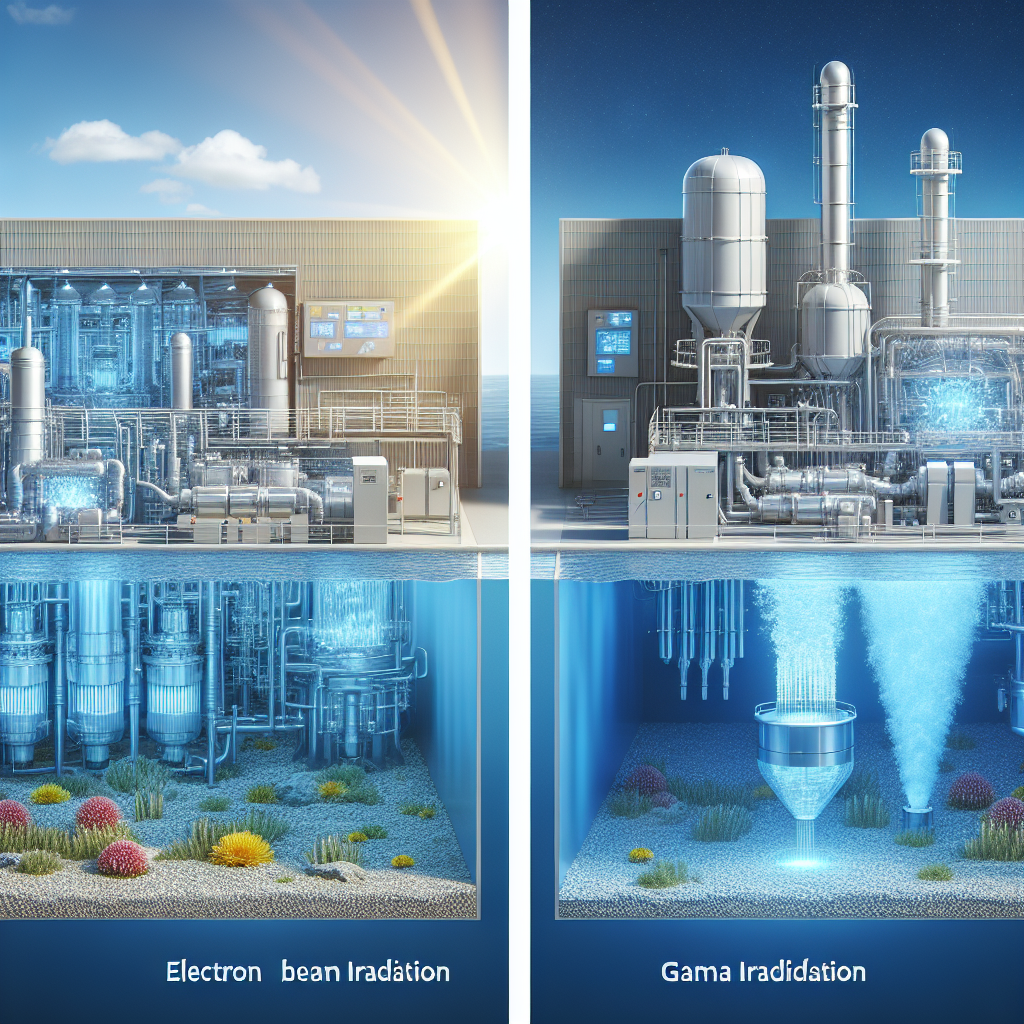Revolutionary Water Treatment: Electron Beam Irradiation Technology

Revolutionary Water Treatment: Electron Beam Irradiation Technology
Introduction
Welcome to the future of water treatment! If you’ve ever wondered how we can keep our water clean and safe without resorting to harsh chemicals, then let me introduce you to the electron beam irradiator. This innovative technology harnesses the power of high-energy electrons to revolutionize the way we treat water, making it safer for both consumption and environmental impact.
Imagine a superhero in the world of sanitation enter electron beam technology, which zaps away harmful pathogens and contaminants with precision. Unlike traditional methods that might leave behind chemical residues, e-beam processing offers a clean and efficient alternative. Think of it as non-thermal pasteurization for your water!
So, what exactly is this wizardry? The e-beam treatment process involves directing accelerated electrons at water contaminants, effectively sterilizing them without the need for heat or chemicals. This means we can tackle everything from industrial wastewater to food safety challenges while adhering to strict electron beam safety standards.
Did you know? E-beam technology is not just limited to water treatment! It also plays a significant role in medical device sterilization and packaging sterilization methods, showcasing its versatility across various industries.
In this post, we’ll dive deep into the applications, advantages, and future trends of electron beam irradiation technology. Whether you’re an engineer looking for advanced irradiation techniques or a municipality exploring eco-friendly sterilization methods, there’s something here for everyone. Buckle up as we explore how this cutting-edge technology is shaping the future of water treatment!
Understanding Electron Beam Technology
Welcome to the world of electron beam technology, where high-energy electrons perform magic in the realm of water treatment! So, what exactly is this wizardry? Let’s break it down.
Definition of Electron Beam Irradiation
At its core, electron beam irradiation (or e-beam irradiation for those in the know) is a process that uses accelerated electrons to sterilize and disinfect various materials. Think of it as a superhero suit for your water, zapping away harmful pathogens and contaminants with precision!
Overview of E-Beam Processing
The e-beam processing method involves directing a stream of high-energy electrons onto a target. This interaction can disrupt the DNA of microorganisms, rendering them harmless. It’s like sending in a SWAT team to tackle bacteria quick, efficient, and highly effective!
Comparison with Traditional Methods
Now, let’s talk about how our beloved electron beam irradiator stacks up against traditional sterilization methods:
| Feature | Electron Beam Irradiation | Traditional Methods (e.g., Chemical Treatment) |
|---|---|---|
| Efficacy | High precision in targeting pathogens. | Variable effectiveness depending on concentration. |
| Treatment Time | Instantaneous results. | Takes longer due to reaction time. |
| Sustainability | Eco-friendly; no chemical residues. | Presents potential chemical hazards. |
In summary, while traditional methods have their place, the advantages offered by an electron beam irradiator are hard to ignore. It’s like comparing an old flip phone to today’s smartphones sure, they both make calls, but one has a lot more tricks up its sleeve!
This groundbreaking technology is paving the way for safer and more efficient water treatment solutions. Stay tuned as we dive deeper into its applications and benefits!
Applications of Electron Beam Irradiation in Water Treatment
When it comes to keeping water clean and safe, the electron beam irradiator is a game-changer! This technology uses high-energy electrons to zap away contaminants, making it a powerful ally in the battle against waterborne pathogens. Let’s dive into some of the most exciting applications of this cutting-edge technology.
E-Beam for Disinfection and Sterilization
The primary application of electron beam technology in water treatment is its ability to disinfect and sterilize. By bombarding water with accelerated electrons, we can effectively reduce or eliminate harmful microorganisms, including bacteria, viruses, and protozoa. This process not only ensures safe drinking water but also enhances the overall quality of treated wastewater.
Use in Wastewater Treatment Processes
Electron beam irradiation is gaining traction in wastewater treatment facilities across the globe. With its ability to break down organic pollutants and pathogens without the need for harsh chemicals, e-beam technology offers an eco-friendly alternative to traditional treatment methods. Imagine transforming wastewater into clean water while reducing chemical usage that’s the magic of electron beam processing!
Food Safety and Irradiation Technology Applications
While we typically think of food safety when discussing electron beam applications, it also plays a vital role in ensuring that our water supply remains uncontaminated during food processing. E-beam irradiation can be used for packaging sterilization methods, ensuring that food products are free from harmful microbes before they hit our tables. This cross-over application not only enhances food safety but also supports better water quality by minimizing contamination risks.
As municipalities and industries look for smarter ways to manage their water resources, the adoption of e-beam services is set to rise. With its proven effectiveness and numerous benefits, it’s time for decision-makers to consider how an electron beam irradiator can enhance their operations.
Advantages of Electron Beam Technology
When it comes to water treatment, the electron beam irradiator isn’t just a fancy gadget; it’s a game changer! Let’s dive into the advantages that make this technology stand out in the crowded field of water treatment solutions.
-
Eco-Friendly Sterilization Methods
One of the biggest perks of using electron beam technology is its eco-friendliness. Unlike traditional chemical methods that can leave behind harmful residues, e-beam processing utilizes high-energy electrons to effectively eliminate pathogens without the need for harsh chemicals. It’s like giving your water a spa day without any of those nasty side effects!
-
High-Energy Electrons and Their Impact on Efficiency
The efficiency of an electron beam sterilization system is nothing short of impressive. With accelerated electrons zipping through at lightning speed, these systems can treat large volumes of water in record time. This means municipalities can scale up their operations without breaking a sweat (or their budgets). Who doesn’t love a good time-saver?
-
Non-Thermal Pasteurization Benefits
Say goodbye to thermal degradation! One of the standout features of e-beam irradiation is its ability to perform non-thermal pasteurization. This is particularly beneficial for sensitive materials that might be harmed by heat like certain polymers or even some food products. It’s like having your cake and eating it too safe treatment without compromising quality!
-
Versatility Across Applications
The versatility of the electron beam irradiator extends beyond just water treatment. From medical device sterilization to food irradiation, e-beam technology finds applications in various fields, making it a jack-of-all-trades in the world of radiation processing. This adaptability enhances its appeal for wastewater treatment operators looking for comprehensive solutions.
-
Simplified Facility Design
The design requirements for an electron beam facility are often simpler than those for traditional gamma irradiation setups. This means less complexity and potentially lower installation costs what’s not to love? -
Enhanced Safety Standards
Electron beam safety standards are rigorously maintained, ensuring that operators and nearby communities are protected from radiation exposure. With proper training and adherence to regulations, e-beam technology can be implemented safely and effectively.
In conclusion, the advantages of electron beam technology make it an attractive option for municipalities and wastewater treatment operators alike. As we look towards more sustainable and efficient methods in water treatment, embracing this innovative approach could very well be the key to unlocking cleaner, safer water solutions.
If you’re considering upgrading your facility or exploring new technologies, why not take a closer look at how an electron beam irradiator could fit into your plans? The future is bright and so is your water!
The E-Beam Treatment Process Explained
So, you’re curious about how the e-beam treatment process works? Buckle up, because we’re diving into the electrifying world of electron beam irradiators!
The e-beam treatment process harnesses the power of high-energy electrons to effectively sterilize and disinfect various materials. This method is not just a flash in the pan; it’s a game changer for industries ranging from food safety to medical device sterilization.
Description of the E-Beam Dosimetry Standards
First off, let’s talk dosimetry. In simple terms, dosimetry standards are like your GPS for irradiation. They help ensure that the right amount of radiation hits the target without going overboard. Think of it as a precision tool that measures how much radiation your materials receive during treatment.
These standards are crucial because they guarantee consistent results and help maintain compliance with safety regulations. In essence, they’re the unsung heroes behind successful e-beam processing!
The Role of Electron Beam Accelerators in Treatment
Now, let’s shine a light on electron beam accelerators these bad boys are at the heart of any electron beam facility design. An electron beam accelerator generates a stream of accelerated electrons that can penetrate materials to achieve effective sterilization.
Picture this: high-energy electrons zooming through space like superheroes on a mission! They collide with microorganisms and pathogens, causing damage to their DNA and rendering them unable to reproduce. It’s like sending those pesky microbes packing!
Irradiation Services Provider Overview
If you’re considering adopting this technology, an irradiation services provider can be your best friend. These professionals specialize in offering e-beam services tailored to your specific needs.
- Consultation: They assess your requirements and recommend suitable solutions.
- Implementation: From setup to operation, they guide you through every step.
- Quality Assurance: Regular checks ensure compliance with e-beam dosimetry standards.
This partnership not only enhances efficiency but also helps you stay ahead in adopting eco-friendly sterilization methods that benefit both your business and the environment!
“Electron beam technology is revolutionizing how we think about sterilization making it faster, safer, and more efficient.”
Electron Beam Safety Standards and Regulations
When it comes to using an electron beam irradiator, safety is not just a checkbox on a list it’s the entire list! Understanding the safety standards and regulations that govern e-beam technology is crucial for anyone involved in radiation processing, whether you’re managing a wastewater treatment facility or exploring food irradiation applications.
Overview of Radiation Safety Standards for E-Beam Technology
The foundation of electron beam safety lies in adhering to established radiation safety standards. These standards are designed to ensure that the use of high-energy electrons does not pose a risk to operators or the environment. Key organizations, such as the International Atomic Energy Agency (IAEA) and the U.S. Environmental Protection Agency (EPA), provide guidelines that must be followed:
- Radiation Protection: Ensuring minimal exposure to personnel through shielding and distance.
- Equipment Safety: Regular maintenance checks on electron beam equipment to prevent malfunctions.
- Training Programs: Mandatory training for operators on safe handling and emergency procedures.
Compliance with Industry Regulations and Guidelines
Navigating compliance can feel like walking through a maze, but it’s essential for safe operations. Here are some important regulations you should be aware of:
- NRC Regulations: The Nuclear Regulatory Commission oversees the use of radioactive materials, which includes certain aspects of electron beam technology.
- OSHA Standards: The Occupational Safety and Health Administration sets forth guidelines to protect workers from radiation hazards.
- AAMI Guidelines: For medical device sterilization, adhering to Association for the Advancement of Medical Instrumentation standards is critical.
Key Takeaway: Staying updated with these standards not only ensures compliance but also enhances operational efficiency making your facility a safer place for everyone involved!
The world of electron beam sterilization is evolving, with new technologies emerging that promise even greater safety measures. As industries increasingly adopt eco-friendly sterilization methods, understanding these regulations will keep you ahead in implementing innovative solutions while maintaining high safety standards.
E-Beam vs Gamma Irradiation: A Comparative Analysis
When it comes to sterilization solutions, two heavyweights take center stage: electron beam irradiation and gamma irradiation. Both methods have their merits, but they operate on different wavelengths literally and metaphorically. Let’s break down these two titans of the irradiation world, shall we?
How They Work
First up, we have the electron beam irradiator. This technology utilizes high-energy electrons generated by an electron beam accelerator. These accelerated electrons are like tiny ninjas, zipping through materials at lightning speed to disrupt microbial DNA.
On the other hand, gamma irradiation relies on radioactive isotopes (like Cobalt-60) to emit gamma rays. Think of it as a slow-moving but powerful freight train very effective but takes a bit longer to get going.
Speed and Efficiency
Key Point: Electron beam processing is faster than gamma radiation, making it ideal for industries that need quick turnaround times.
E-beam technology can achieve high doses in mere seconds, while gamma treatments often take hours or even days. For municipalities and wastewater treatment operators looking to optimize their processes, speed can be a game changer.
Applications and Versatility
| Feature | E-Beam Irradiation | Gamma Irradiation |
|---|---|---|
| Food Irradiation | Highly effective for food safety and packaging sterilization methods. | Suitable but slower process. |
| Medical Device Sterilization | Preferred for precision electron beams in medical applications. | A common choice but less efficient in terms of time. |
| Polymer Modification | E-beam is often used for enhancing polymer properties. | Lesser used for this application. |
Safety Considerations
p>The safety standards surrounding both methods are stringent. However, e-beam technology tends to be viewed as more user-friendly since it does not involve radioactive materials. This means fewer regulatory hurdles for facilities looking to implement an electron beam facility design.
h3>Cultural Perception and Misconceptions
,
p>A common misconception is that gamma irradiation is always superior due to its long-standing presence in the market. However, as e-beam technology continues to evolve with advancements like eco-friendly sterilization methods, it’s clear that it’s not just a newcomer it’s here to stay!
p>The final takeaway? While both e-beam and gamma irradiation have unique advantages, the choice largely depends on specific needs such as speed, application type, and safety considerations. As we venture further into the world of advanced irradiation techniques, understanding these differences will help municipalities and engineers make informed decisions about their water treatment processes.
Future Trends in Electron Beam Applications for Water Treatment
The future of electron beam irradiation technology in water treatment is looking brighter than a freshly polished water filtration system. As we dive into the trends shaping this innovative field, it’s clear that the electron beam irradiator is not just a passing fad; it’s set to revolutionize how we approach water purification.
1. Enhanced E-Beam Processing Techniques
Expect to see advancements in electron beam technology that enhance processing speeds and efficiency. With the development of faster electron beam accelerators, municipalities will be able to treat larger volumes of water without compromising effectiveness. This means cleaner water at a lower cost what’s not to love?
2. Integration with Smart Technologies
The rise of smart cities is influencing how we manage resources, and water treatment is no exception. Future electron beam applications will likely incorporate IoT (Internet of Things) technologies, allowing for real-time monitoring and optimization of the e-beam treatment process. Imagine being able to adjust settings based on immediate data feedback talk about futuristic!
3. Eco-Friendly Innovations
As sustainability becomes increasingly important, the use of electron beam sterilization will expand due to its eco-friendly benefits. Unlike traditional methods that often involve harmful chemicals, e-beam technology offers a non-thermal pasteurization alternative that minimizes environmental impact while ensuring effective sterilization.
4. Collaboration Across Industries
The future will see more collaboration between industries utilizing electron beam equipment for various applications think food safety and medical device sterilization teaming up with wastewater treatment plants! These partnerships can lead to innovative solutions that leverage the strengths of each sector, ultimately improving public health outcomes.
5. Advanced E-Beam Dosimetry Standards
The evolution of dosimetry standards will play a crucial role in ensuring safety and effectiveness in e-beam treatments. As regulations tighten around radiation processing, expect advancements in dosimetry techniques that provide precise measurements for optimal dosing during the e-beam treatment process.
According to recent studies, integrating advanced electron beam applications can reduce chemical usage in wastewater treatment by up to 50%.
6. Public Awareness and Acceptance
A key aspect of future trends will be increasing public awareness about the benefits and safety standards associated with electron beam technology. Educational campaigns can dispel misconceptions surrounding radiation sterilization and highlight how these methods contribute positively to community health.
In summary, the future trends in electron beam applications for water treatment are not just exciting; they are essential for creating sustainable solutions that meet modern challenges head-on. As we embrace these innovations, we can look forward to cleaner, safer water for all!
Conclusion
As we wrap up our deep dive into the world of electron beam irradiators, it’s clear that this technology is not just a passing trend it’s a game changer in water treatment and beyond. The precision and efficiency offered by e-beam technology are reshaping how we approach disinfection, sterilization, and even food safety.
The advantages of using an electron beam accelerator are manifold. From eco-friendly sterilization methods to non-thermal pasteurization, the benefits are hard to ignore. With the ability to process high-energy electrons effectively, industries can achieve superior results compared to traditional methods like gamma irradiation.
Moreover, as we look towards the future, the potential applications of this technology seem limitless. Whether it’s enhancing wastewater treatment processes or ensuring medical device sterilization meets stringent safety standards, e-beam services are paving the way for innovative solutions across various sectors.
Key Takeaway: Embracing electron beam technology can lead to significant improvements in efficiency and safety for water treatment facilities. Don’t get left behind; consider integrating these advanced irradiation techniques into your operations!
If you’re part of a municipality or an engineering team looking to upgrade your systems, now is the time to explore partnerships with reputable irradiation services providers. The future of water treatment is bright with electron beam applications leading the charge!





